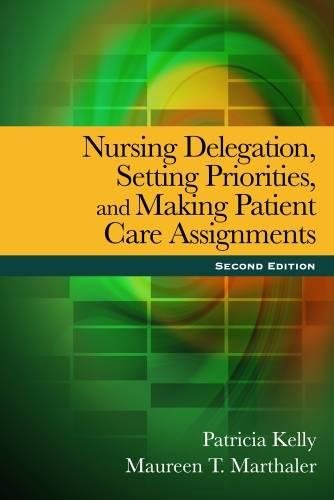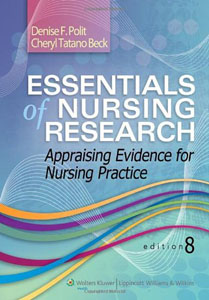Nursing Delegation, Setting Priorities And Making Patient Care Assignments 2nd Edition by Patricia Kelly test bank
Original price was: $55.00.$22.00Current price is: $22.00.
Digital item No Waiting Time Instant Download
ISBN-10: 143548178X ISBN-13: 978-1435481787
Publisher : Cengage Learning; 2nd edition
Authors: Patricia Kelly, Maureen T Marthaler
Description
Nursing Delegation, Setting Priorities And Making Patient Care Assignments 2nd Edition by Patricia Kelly test bank
Chapter 2: NCSBN Delegation Decision-Making Tree and the Five Rights
MULTIPLE CHOICE
1. The National Council of State Boards of Nursing (NCSBN) Delegation Decision-Making Tree consists of four steps. Which of the following is not one of these steps?
|
a. |
assessment of the patient, staff, and situational context |
|
b. |
planning of the context based on the delegation needs |
|
c. |
surveillance, supervision, and monitoring of the delegation to assure compliance with standards of practice, policy, and procedures |
|
d. |
evaluation and feedback to consider the effectiveness of the delegation |
ANS: B
The National Council of State Boards of Nursing (NCSBN) developed a Delegation Decision-Making Tree as a means of providing consistent guidelines for nursing delegation of staff. The NCSBN Delegation Decision-Making Tree consists of four steps: 1) assessment of the patient, staff, and situational context, and planning of the delegation based upon the patient’s needs and resources available (not planning of the context based on the delegation needs); 2) communication with the delegate to provide direction and opportunities for interaction while the task is being completed; 3) surveillance, supervision, and monitoring of the delegation to assure compliance with standards of practice, policy, and procedures; and 4) evaluation and feedback to consider the effectiveness of the delegation.
PTS:1DIF:Comprehension
TOP: The National Council of State Boards of Nursing (NCSBN) Delegation Decision-Making Tree
2.A nurse who will be delegating some nursing tasks to other staff members has considered the client’s health care status and stability of condition, the predictability of risks and responses, the setting where the care occurs, and the complexity of the task being performed. Which of the four steps of the NCSBN Delegation Decision-Making Tree was used?
|
a. |
assessment |
|
b. |
communication and planning |
|
c. |
surveillance and supervision |
|
d. |
evaluation and feedback |
ANS: C
Step Three: Surveillance and supervision in the NCSBN Delegation Decision-Making Tree is related to the nurse’s responsibility for client care from a supervisory role. The nurse who operates in this stage considers client’s health care status and stability of condition, predictability of risks and responses, setting where the care occurs, and complexity of the task being performed; determines the frequency of the supervision required; and is responsible for the timely intervention and follow-up based on problems and concerns (NCSBN, 1995).
PTS:1DIF:Application
TOP: The National Council of State Boards of Nursing (NCSBN) Delegation Decision-Making Tree
3.When a nurse decides to delegate a nursing task to others, a number of considerations take place before the decision itself is made. Which of the following is not one of these considerations?
|
a. |
needs of the patient |
|
b. |
condition of the patient |
|
c. |
potential harm |
|
d. |
status of the staff |
ANS: D
Decisions to delegate nursing tasks take into consideration a number of factors. Some of these include: 1) needs of the patient; 2) condition of the patient; 3) potential harm; 4) stability of the patient’s condition; 5) the task itself; 6) the ability to predict the outcome of the delegation; and 7) knowledge of the staff’s competencies and abilities.
PTS:1DIF:Comprehension
TOP: The Five Rights of Delegation
4.Education, training, utilization, and legal parameters for nurses are guided by a number of organizations and acts/laws. Which of the following is not one of these organizations or acts/laws?
|
a. |
State Nurse Practice Act |
|
b. |
ANA |
|
c. |
IOM |
|
d. |
State Boards of Nursing |
ANS: C
The scope of nursing practice, education, training, utilization, and legal parameters of nursing practice are guided and defined by a number of organizations and legal acts. Some of these include: 1) State Nurse Practice Act; 2) ANA; 3) NCSBN (not the IOM, which is the Institute of Medicine); and 4) State Boards of Nursing.
PTS: 1 DIF: Knowledge TOP: Regulations
5.Nursing tasks that can sometimes be delegated if the staff has received additional speciality training and credentialing are listed below. Which of the following is not correct?
|
a. |
sterile procedures |
|
b. |
medication administration |
|
c. |
IV therapy |
|
d. |
health teaching |
ANS: D
Some nursing tasks which are not commonly delegated can be delegated to staff members who have received specialty training and credentialing. Some of these tasks include: 1) sterile procedures; 2) medication administration; 3) IV therapy; 4) care of broken skin and other minor cuts or abrasions; and 5) invasive procedures such as inserting tubes into body cavities and instilling substances via an indwelling tube. Tasks that cannot be delegated include: 1) health teaching; 2) planning of care; and 3) evaluation of care given.
PTS: 1 DIF: Knowledge TOP: Regulations
6.Organizations have certain responsibilities to their staff and employees. Some of these organizational responsibilities are listed below. Which of the following is not one of these organizational responsibilities regarding nursing staff?
|
a. |
designing policies and procedures that are congruent with the State Nurse Practice Act |
|
b. |
documenting staff competencies for staff who provide direct patient care |
|
c. |
implementing a system that ensures ongoing education of only registered nurses to maintain their competencies |
|
d. |
allocating resources for adequate nurse staffing that allows the nurse to delegate appropriately |
ANS: C
Organizations are responsible for providing an environment that is conducive to the determination and maintenance of competent staff and for effective nursing delegation. Some of these organizational responsibilities include: 1) designing policies and procedures that are congruent with the State Nurse Practice Act; 2) documenting staff competencies for staff who provide direct patient care; 3) implementing a system that ensures ongoing education of the staff (not only registered nurses) to maintain their competencies; and 4) allocating resources for adequate nurse staffing that allows the nurse to delegate appropriately (ANA and NCSBN, 2006).
PTS: 1 DIF: Comprehension TOP: Regulations
7.Acquiring the ability to effectively delegate nursing tasks involves different types of skills and experiences. Some of these are listed below. Which is not necessarily correct regarding primary means by which nurses learn how to delegate?
|
a. |
using intuition of how to delegate first |
|
b. |
discussion of knowledge and skills related to delegation |
|
c. |
clinical mentorship |
|
d. |
practice of responsibilities related to delegation |
ANS: A
Delegation of nursing tasks consists of knowledge, skill, behavior, experience, and training. Some ways in which nurses learn how to effectively delegate are: 1) discussion of knowledge and skills related to delegation; 2) clinical mentorship; and 3) practice of responsibilities related to delegation. While intuition may be helpful for nurses in certain situations, it is not considered a key or primary means by which nurses learn how to effectively delegate nursing tasks.
PTS: 1 DIF: Application TOP: Knowledge and Skill of Delegation
8.Nurse B is respected and admired by her staff and it has been noted that she seems to have the ability to attract people and is considered to have great vision for the future of the unit and nursing in general. What type of power is Nurse B exhibiting?
|
a. |
expert |
|
b. |
referent (charisma) |
|
c. |
connection |
|
d. |
reward |
ANS: B
Fisher & Koch (1996) identified a kind of power where an individual is perceived to be charismatic in nature and of great vision. This type of power is called “referent” or “charisma” power. Nurse B in the example given above is exhibiting this type of power as she is respected and admired by her staff, is considered to have great vision, and seems to have an ability to attract people. Expert power is derived from an individual’s knowledge and skills (Fisher & Koch, 1996). Connection power is derived from the connections that people have together such as teamwork, collaboration, networking, and mentoring (Miller, 2003). Reward power is based on the individual’s ability to reward or punish others (Miller, 2003).
PTS: 1 DIF: Comprehension TOP: Power
9.You have just received your annual performance review from your nurse manager. He has given you a 3% merit increase to your salary. What type of power is he exhibiting with this merit increase (raise)?
|
a. |
expert |
|
b. |
legitimate |
|
c. |
referent |
|
d. |
reward |
ANS: D
Reward power is power that is derived from the ability to reward or punish others (Fisher & Koch, 1996). The nurse manager in the example above is demonstrating reward power in the distribution of a 3% merit increase (raise) in salary. Expert power is derived from knowledge and expertise which the nurse manger most likely also has, but this is not demonstrated in this example. Referent power or charisma is derived from a perceived admiration, trust, and respect that individuals feel toward another person based on their ability to inspire confidence, be a great visionary, or display attributes of charisma (Miller, 2003).
PTS: 1 DIF: Comprehension TOP: Power
10.New graduate nurses may have difficulty with effective delegation. Some ways in which other staff can assist new graduate nurses with their delegation are listed below. Which is not necessarily correct?
|
a. |
Help new nurses in their role development. |
|
b. |
Teach new nurses how to delegate. |
|
c. |
Introduce department staff. |
|
d. |
Critique the delegation using reward power. |
ANS: D
New nurse graduates and novice nurses may experience difficulty when learning how to effectively delegate nursing tasks to others. Some ways in which other staff members can assist these nurses in acquiring the skills, knowledge, experience, and confidence for delegation include: 1) help new nurses in their role development; 2) teach new nurses how to delegate; 3) introduce departmental staff; and 4) explain the roles of different departmental staff with whom they may come in contact. While feedback and constructive criticism may be helpful for new nurses when learning how to delegate, this should come from the nurse manager and not from all staff.
PTS: 1 DIF: Analysis TOP: Responsibilities of Health Team Members





Be the first to review “Nursing Delegation, Setting Priorities And Making Patient Care Assignments 2nd Edition by Patricia Kelly test bank”